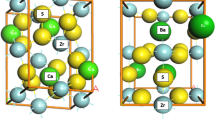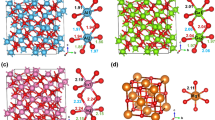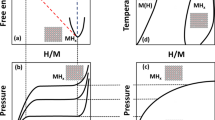Abstract
A fundamental property of electrostatic potentials is their additivity. This study demonstrates that the electrostatic potential of a negatively charged, cation-substituted phyllosilicate layer can be represented as the sum of two potentials. Viewing cation substitution as a defect, one potential is derived from the atoms in a charge-neutral, unsubstituted layer such as pyrophyllite or talc. The “neutral-layer” potential rapidly decays to zero with distance from the layer and is determined primarily by the atoms in the first two atomic planes parallel to the (001) surface, i.e., the basal oxygens and tetrahedral cations. The second component, characterized as a “defect” potential, is a long-range potential derived from cation-substitution. The model used to compute the electrostatic potentials, a two-dimensional Ewald lattice sum, represents the atoms of a single phyllosilicate layer as point charges.
Similar content being viewed by others
References
Bailey, S. W. (1975) Cation ordering and pseudosymmetry in layer silicates: Amer. Mineral. 60, 175–187.
Banos, J. O. (1985) Interlayer energy for partial slip and cleavage in muscovite: Philos. Mag. A 52, 145–152.
Bertaut, E. F. (1978) Electrostatic potentials, fields and field gradients: J. Phys. Chem. Solids 39, 97–102.
Bleam, W. F. and Hoffmann, R. (1988) Isomorphous substitution in phyllosilicates as an electronegativity perturbation: Its effect on bonding and charge distribution: Phys. Chem. Minerals 15, 398–408.
Bolt, G. H. (1979) The ionic distribution in the diffuse double layer: in Soil Chemistry B. Physico-Chemical Models, G. H. Bolt, ed., Elsevier, Amsterdam, 1–25.
Brown, I. D. (1978) Bond valences—A simple structural model for inorganic chemistry: Chem. Soc. Rev. 7, 359–376.
Conard, J., Estrade-Szwarckopf H., Dianoux, A. J., and Poin-signon, C. (1984) Water dynamics in a planar lithium hydrate in the interlayer space of a swelling clay. A neutron scattering study: J. Phys. 45, 1361–1371.
Fanner, V. C. (1978) Water on particle surfaces: in The Chemistry of Soil Constituents, D. J. Greenland and M. H. B. Hayes, eds., Wiley, New York, 405–448.
Farmer, V. C. and Russell, J. D. (1971) Interlayer complexes in layer silicates. The structure of water in lamellar ionic solutions: Trans. Faraday Soc. 67, 2737–2749.
Foot, J. D. and Colburn, E. A. (1988) Electrostatic potentials for surfaces of inorganic and molecular crystals: J. Mol. Graphics 6, 93–99.
Fripiat, J. G., Lucas, A. A., André, J. M., and Derouane, E. G. (1977) On the stability of polar surface planes of macroscopic ionic crystals: Chem. Phys. 21, 101–104.
Fripiat, J. J., Kadi-Hanifi, M., Conard, J., and Stone, W. E. E. (1980) NMR study of adsorbed water—III. Molecular orientation and protonic motions in the one-layer of a Li hectorite: in Magnetic Resonance in Colloid and Interface Science, J. P. Fraissard and H. A. Resing, eds., Reidel, Boston, 529–535.
Giese, R. F. (1979) Hydroxyl orientations in 2:1 phyllosilicates: in Clays and Clay Minerals, Proc. 13th Natl. Conf, Madison, Wisconsin, 1964, W. F. Bradley and S. W. Bailey, eds., Pergamon Press, New York, 105–144.
Giese, R. F. (1984) Electrostatic energy models of micas: Rev. Mineral. 13, 105–144.
Heyes, D. M. and van Swol, F. (1981) The electrostatic potential and field in the surface region of lamina and semi-infinite point charge lattices: J. Chem. Phys. 75, 5051–5058.
Hoffmann, R. (1963) An extended Hiickel theory. I. Hydrocarbons: J. Chem. Phys. 39, 1397–1412.
Hoffmann, R. and Lipscomb, W. N. (1962) Theory of polyhedral molecules. I. Physical factorizations of the secular equation: J. Chem. Phys. 36, 2179–2189.
Jenkins, H. D. B. and Hartman, P. (1979) A new approach to the calculation of electrostatic energy relations in minerals: The dioctahedral and trioctahedral phyllosilicates: Philos. Trans. Royal Soc. London Ser. A 293, 169–208.
Jenkins, H. D. B. and Hartman, P. (1980) Application of a new approach to the calculation of electrostatic energies of expanded di- and trioctahedral micas: Phys. Chem. Minerals 6, 313–325.
Jenkins, H. D. B. and Hartman, P. (1982) Calculations on a model intercalate containing a single layer of water molecules: A study of potassium vermiculite, K2lMg6-(Si4_xAlJ2O20(OH)4, for 1 < × < 0: Philos. Trans. Royal Soc. London Ser. A 304, 397–446.
Kittel, C. (1986) Introduction to Solid State Physics: 6th ed., Wiley, New York, 646 pp.
Kjellander, R. and Marcelja, S. (1985) Polarization of water between molecular surfaces: A molecular dynamics study: Chemica Scripta 25, 73–80.
Lee, J. J. and Guggenheim, S. (1981) Single crystal x-ray refinement of pyrophyllite-17c: Amer. Mineral. 66, 350–357.
Lee, W. W. and Choi, S.-I. (1980) Determination of the Madelung potential of ionic crystals with a polar surface by the Ewald method: J. Chem. Phys. 72, 6164–6168.
Low, P. F. (1962) Influence of adsorbed water on exchangeable ion movement: in Clays and Clay Minerals, Proc. 9th Natl. Conf, West Lafayette, Indiana, 1960, Ada Swineford, ed., Pergamon Press, New York, 219–228.
Mathieson, A. McL. and Walker, G. F. (1954) Crystal structure of magnesium-vermiculite: Amer. Mineral. 39, 231–255.
McBride, M. B. (1989) Surface chemistry of soil minerals: in Minerals in Soil Environments: 2nd ed., J. B. Dixon and S. B. Weed, eds., Soil Science Society of America, Madison, Wisconsin, 35–87.
Odom, I. E. (1984) Smectite clay minerals: Properties and uses: Philos. Trans. Royal Soc. London Ser. A 311, 391–409.
Parry, D. E. (1975) The electrostatic potential in the surface region of an ionic crystal: Surface Sci. 49, 433–440.
Parry, D. E. (1976) Errata: The electrostatic potential in the surface region of an ionic crystal: Surface Sci. 54, 195.
Pauling, L. (1929) The principles determining the structure of complex ionic crystals: J. Amer. Chem. Soc. 51, 1010–1026.
Perdikatsis, B. and Burzlaff, H. (1981) Strukturverfeinerung am Talk Mg3[(OH)2Si4O10]: Z. Kristallogr. 156, 177–186.
Prost, R. (1975) Interactions between adsorbed water molecules and the structure of clay minerals: Hydration mechanism of smectites: in Proc. Int. Clay Conf, Mexico City, 1975, S. W. Bailey, ed., Applied Publishing, Wilmette, Illinois, 351–359.
Shirozu, H. and Bailey, S. W. (1966) Crystal structure of a two-layer Mg-vermiculite: Amer. Mineral. 51, 1124–1143.
Slade, P. G., Stone, P. A., and Radoslovich, E. W. (1985) Interlayer structures of the two-layer hydrates of Na- and Ca-vermiculites: Clay & Clay Minerals 33, 51–61.
Smith, E. R. (1983) Electrostatic potential at a plane surface of a point ionic crystal: Physica 120A, 327–338.
Sposito, G. (1984) The Surface Chemistry of Soils, Oxford University Press, New York, 234 pp.
Sposito, G. (1989) Surface reactions in natural aqueous colloidal systems: Chimia 43, 169–176.
Sposito, G. and Prost, R. (1982) Structure of adsorbed water on smectites: Chem. Rev. 82, 553–573.
Veitch, L. G. and Radoslovich, E. W. (1963) The cell dimensions and symmetry of layer-lattice silicates. III. Octahedral ordering: Amer. Mineral. 48, 62–75.
Watson, R. E., Davenport, J. W., Perlman, M. L., and Sham, T. K. (1981) Madelung effects at crystal surfaces: Implications for photoemission: Phys. Rev. B 24, 1791–1797.
Weiss, Z., Rieder, M., Chmielova, M., and Krajicek, J. (1985) Geometry of the octahedral coordination in micas: A review of refined structures: Amer. Mineral. 70, 747–757.
Whangbo, M.-H., Hoffmann, R., and Woodward, R. B. (1979) Conjugated one and two dimensional polymers: Proc. Royal Soc. London Ser. A 366, 23–46.
Author information
Authors and Affiliations
Rights and permissions
About this article
Cite this article
Bleam, W.F. The Nature of Cation-Substitution Sites in Phyllosilicates. Clays Clay Miner. 38, 527–536 (1990). https://doi.org/10.1346/CCMN.1990.0380510
Received:
Accepted:
Published:
Issue Date:
DOI: https://doi.org/10.1346/CCMN.1990.0380510




